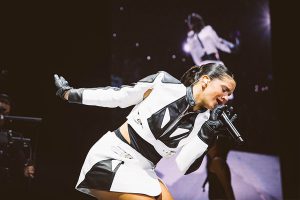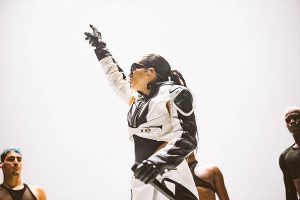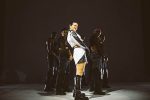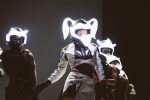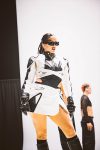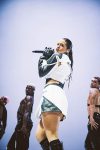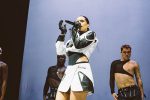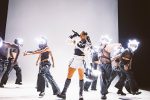REVIEW: Rosalía all that and more at ‘MOTOMAMI’ Bill Graham Civic show

Rosalía performs at Bill Graham Civic Auditorium in San Francisco, Calif. on Oct. 4, 2022. Matt Pang/STAFF.
SAN FRANCISCO — A generation ago, maybe more recently, the gorgeous music of Spanish artist Rosalía Vila I Tobella might have been relegated to a “world” music bin at the record shop. Her concoction of flamenco, bachata, jazz and other European, Mediterranean and Middle-Eastern sounds, mixed with a vocal delivery of rich soprano that reaches low, high and near-operatic vibrato, wasn’t on the radio.
What changed? The internet, global tastes—but just as importantly, the ability of Rosalía to filter those traditional sounds through the lens of reggaetón and hyper-pop or PC music. The result was a glitchy surreal sound that’s all about the future without sacrificing its roots. And Rosalía, who just turned 30 last month, is certainly having her moment right now. Her third album, Motomami, has just been nominated for eight Latin Grammys including Album, Record and Song of the year, and it’s Metacritic’s highest-ranked album of 2022.
About midway through the North American portion of her world tour, Rosalía made her Bay Area stop at Bill Graham Civic Auditorium, which was so full by the end of the night that even the aisles between sections of seats above the floor were crowded.
In addition to the impeccable singing—which was somehow crystal clear, even through the din of the most bass-heavy songs—and the musicality (Rosalía mostly performed to backing tracks yet showed she could do more when she played guitar or a grand piano that had been dragged onto the stage) the show production showed that the artist’s vision stands up to her acclaim.
The sparse stage was decorated only with some spotlights and a giant white photo background (like the kind in a photo studio, but this one reached from the stage floor to the ceiling) that was actually a video screen. It was flanked by two smaller video screens. Rosalía performed most of the show surrounded by her team of dancers—called motopapis—or a videographer whose near-constant presence, weaving between the dancers or right in the performer’s face, made him a part of the show.
The show began with the dancers zombie-walking while wearing lit-up motorcycle helmets. One of them in the middle of their scrum removed a helmet, revealing herself as Rosalía, stepping through the dancers to the front. She kickstarted the music with jazzy banger “SAOKO,” which also begins the album. The dancers wore black, and she wore a monochromatic black and white outfit that a include a motorcycle jacket, which created a stark visual against the white backdrop.
Through a deafening roar, the performers transitioned to “CANDY,” TikTok smash “BIZCOCHITO,” and the rumba-like “LA FAMA.” During the latter, even the dancers walked around with cameras, capturing views of each other and the singer. There were also cameras below and above the stage, and the quick cuts felt like channel-flipping through different views of the same program.
Rosalía addressed the adoring crowd in both Spanish and English throughout the show, all while fans tossed gifts onto the stage, some of which the singer picked up. There were numerous hats and even a bag of M&Ms, which she tore open and indulged.
“I’m really grateful, really happy. The first time I came, I fell in love with this city, this energy,” she said early in the show while soaking up the crowd response.
The artsy dancers didn’t distract from the star, as so often happens when an artist is alone on stage. Instead, they heightened the drama and the emotional swings Rosalía was conveying in her songs.
And there were plenty of twists and turns thanks to a set that jumped back and forth between bangers, alt-pop numbers and touching stripped-down ballads. Make one thing clear, though: All of these songs shone a light on Rosalía’s singing ability. Credit is due to the person who set up the sound for the show. She strummed a guitar on “Dolerme,” but this beautiful rendition felt too brief.
An early highlight came during the new album’s title track, where the dancers transformed, “Voltron”-style, into a motorcycle—which she mounted and sang from. At other times in the show, she sang while seated in a salon chair, while lying on her belly flat on the floor, while being carried over the heads of the dancers, while spinning on a small pedestal, and while riding around the stage on scooters. Just about the only thing she didn’t do was sing while suspended upside down. She could probably do that, too.
During the show, Rosalía explained how she wrote lovelorn organ-led ballad “G3 N15” as a letter to a special someone while she was away from him, working on the new album. During “LA NOCHE DE ANOCHE,” a duet with Bad Bunny, she walked down a set of stairs to the barricade at the front of the stage, where fans were practically lying on top of each other.
She pointed her microphone into their faces to sing Bad Bunny’s parts. How much of herself she was putting over the barricade required tremendous trust, as dozens of arms reached out to grab her every time she did this.
In the salon chair bit, during “DIABLO,” she was given a towel and began wiping off her makeup. She took a pair of scissors and appeared to cut off one of her braids. Considering this same thing has happened at other shows on this tour, what’s the likelihood the hair was real and not an extension? You’d think she would have run out of hair to cut before the tour ends. Nonetheless, the crowd ate this up, too, and she threw the braid as far as she could into the mass of fans on the floor.
During “HENTAI,” someone who doesn’t understand Spanish would have been surprised at the songs racy lyrics based on Rosalía’s impassioned performance on the piano, her sweet vibrato rising above the mix.
And during the psychedelic yet Middle-Eastern-sounding “De plata,” off 2017 album Los Ángeles, Rosalía’s dancers brought out a 30-foot-long black train that they attached up to her waist. From above, it looked like a giant black cloud enveloping everyone in its path. By the end of the song, tears were streaming down her face.
At this point, the pace picked up even more. Rosalía sped through “LA COMBI VERSACE” and other songs and features in other artists’ songs at a blistering speed. One highlight of this portion of the show included her feature in a remix of The Weeknd’s “Blinding Lights,” singing in both Spanish and English.
“DESPECHÁ,” meanwhile, turned into a dancing showcase on stage. Some of the people on stage looked like they had been pulled from the crowd. Perhaps no song mirrored the show as a whole as much as “CHIRI,” which switched back and forth between bass-heavy sections and airier instrumentation, over which Rosalía sang in an airtight falsetto.
One of the longer songs of the night was her cover of Cuban artist Justo Betancourt’s 1968 song “Delirio de Grandeza” (also on Motomami). There were more than 30 songs in all, which were covered in about one hour and 45 minutes. Most seats were still filled by the time she got to the encore. She and her dancers rode onto the stage on scooters for hit “CHICKEN TERIYAKI.”
- Rosalía performs at Bill Graham Civic Auditorium in San Francisco, Calif. on Oct. 4, 2022.
- Rosalía performs at Bill Graham Civic Auditorium in San Francisco, Calif. on Oct. 4, 2022.
- Rosalía performs at Bill Graham Civic Auditorium in San Francisco, Calif. on Oct. 4, 2022.
- Rosalía performs at Bill Graham Civic Auditorium in San Francisco, Calif. on Oct. 4, 2022.
- Rosalía performs at Bill Graham Civic Auditorium in San Francisco, Calif. on Oct. 4, 2022.
- Rosalía performs at Bill Graham Civic Auditorium in San Francisco, Calif. on Oct. 4, 2022.
- Rosalía performs at Bill Graham Civic Auditorium in San Francisco, Calif. on Oct. 4, 2022.
- Rosalía performs at Bill Graham Civic Auditorium in San Francisco, Calif. on Oct. 4, 2022.
- Rosalía performs at Bill Graham Civic Auditorium in San Francisco, Calif. on Oct. 4, 2022.
- Rosalía performs at Bill Graham Civic Auditorium in San Francisco, Calif. on Oct. 4, 2022.
- Rosalía performs at Bill Graham Civic Auditorium in San Francisco, Calif. on Oct. 4, 2022.
- Rosalía performs at Bill Graham Civic Auditorium in San Francisco, Calif. on Oct. 4, 2022.
Follow editor Roman Gokhman at Twitter.com/RomiTheWriter.


